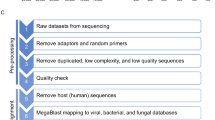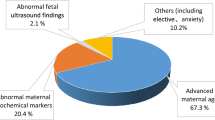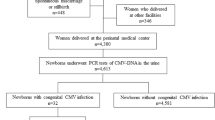Abstract
MYCOPLASMAS are common contaminants of cells in culture and are often responsible for profound alterations in the metabolism of infected cells1,2. Such alterations include chromosomal aberrations3,4 and changes in host cell enzyme activities5. We have reported that amniotic fluid cell cultures contaminated with mycoplasmas revealed a significant increase in chromosomal aberrations over those seen in uninfected cultures6. This finding demonstrated that the presence of these organisms in amniotic fluid cell lines poses a potential hazard to prenatal chromosome diagnosis.
This is a preview of subscription content, access via your institution
Access options
Subscribe to this journal
Receive 51 print issues and online access
$199.00 per year
only $3.90 per issue
Buy this article
- Purchase on Springer Link
- Instant access to full article PDF
Prices may be subject to local taxes which are calculated during checkout
Similar content being viewed by others
References
Stanbridge, E., Bact. Rev., 35, 206–221 (1971).
Fogh, J., Holmgren, N. B., and Ludovici, P. P., In Vitro, 7, 26–41 (1971).
Paton, G. R., Jacobs, J. P., and Perkins, F. T., Nature, 207, 43–45 (1965).
Stanbridge, E., Onen, M., Perkins, F. T., and Hayflick, L., Expl Cell Res., 57, 397–410 (1969).
Rose, N. R., Milisauskas, V., and Kite, J. H., Jr, Proc. Soc. exp. Biol. Med., 140, 390–394 (1972).
Schneider, E. L., et al., Science, 184, 477–480 (1974).
Nadler, H. L., Adv. Human Genet., 3, 1–38 (1972).
Szybalski, W., Szybalska, E. H., and Ragni, G., Natn. Cancer Inst. Monogr., 7, 75–89 (1962).
Tischfield, J. A., Bernhard, H. P., and Ruddle, F. H., Analyt. Biochem., 53, 545–554 (1973).
Razin, S., J. Microbiol., 28, 243–250 (1962).
Brunner, H., James, W. D., Horswood, R. L., and Chanock, R. M., J. Immun., 108, 1491–1498 (1972).
DeMars, R., Santo, G., Felix, J. S., and Benke, P., Science, 164, 1303–1305 (1969).
Okada, S., and O'Brien, J. S., Science, 165, 698–700 (1969).
Harris, H., Birth Defects, 9, 132–137 (1973).
Bakay, B., Croce, C. M., Koprowski, H., and Nyhan, W. L., Proc. natn. Acad. Sci. U.S.A., 70, 1998–2002 (1973).
Tischfield, J. A., and Ruddle, F. H., Proc. natn. Acad. Sci. U.S.A., 71, 45–49 (1974).
Author information
Authors and Affiliations
Rights and permissions
About this article
Cite this article
STANBRIDGE, E., TISCHFIELD, J. & SCHNEIDER, E. Appearance of hypoxanthine guanine phosphoribosyltransferase activity as a consequence of mycoplasma contamination. Nature 256, 329–331 (1975). https://doi.org/10.1038/256329a0
Received:
Accepted:
Issue Date:
DOI: https://doi.org/10.1038/256329a0
This article is cited by
-
Cytogenetic effects of mycoplasmal infection of cell cultures: A review
In Vitro (1984)
-
An autoradiographic method of detectingA. laidlawii andM. hyorhinis in cell cultures
In Vitro (1981)
-
An ultramicrochemical test for mycoplasmal contamination of cultured cells
In Vitro (1979)
-
Detection of mycoplasma contamination in tissue cultures by fluorescence microscopy
Human Genetics (1979)
-
Endogenous HPRT activity in mycoplasmas isolated from cell cultures
In Vitro (1978)
Comments
By submitting a comment you agree to abide by our Terms and Community Guidelines. If you find something abusive or that does not comply with our terms or guidelines please flag it as inappropriate.



